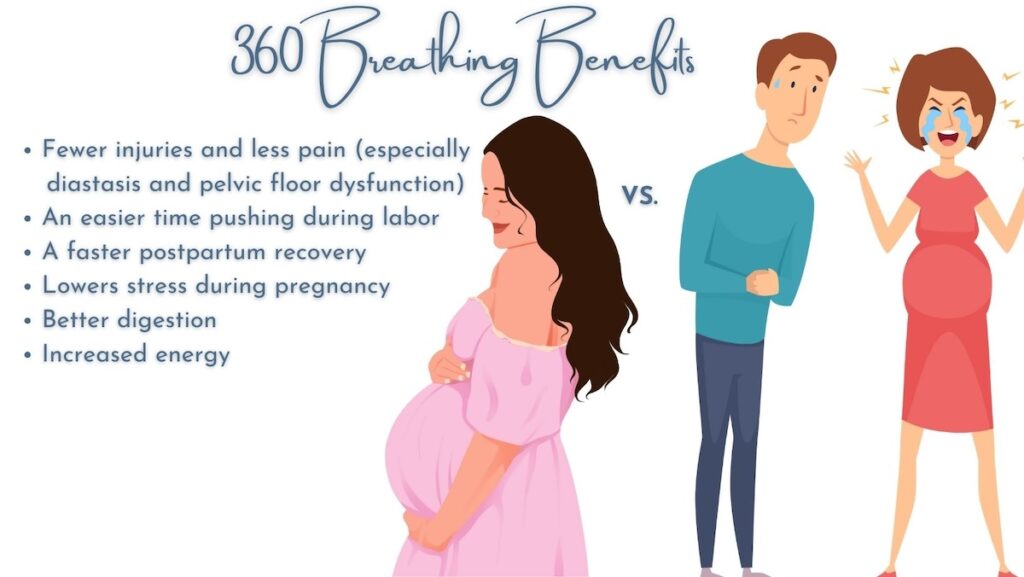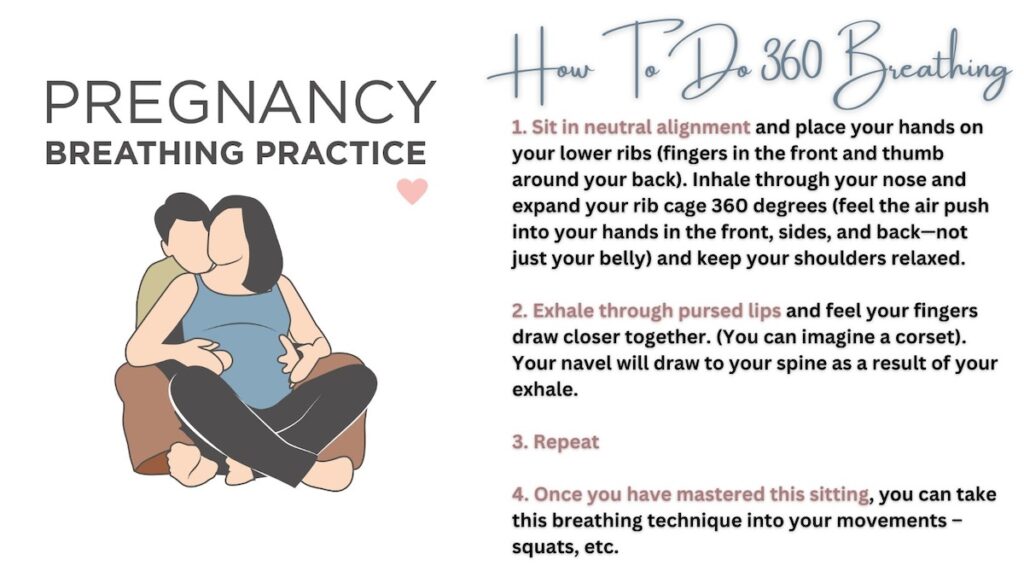Diaphragm or 360 breathing is a technique that engages the entire circumference of the torso, promoting optimal oxygen exchange and enhancing the body’s relaxation response. Focusing on deep, controlled inhalations that expand the belly, sides, and back equally encourages the diaphragm to descend fully and the lungs to fill more efficiently with air. This technique not only improves respiratory efficiency but also helps reduce stress, lower blood pressure, and improve core stability by engaging and strengthening the muscles around the spine and abdomen. Practicing diaphragm breathing can lead to better posture, reduced anxiety levels, and overall well-being, making it a valuable practice for physical and mental health.
Enjoy the entire article or the topics most important to you!
Why is 360 breathing so important during pregnancy and after birth?
360-breathing is a style of breathing that synchronizes your diaphragm, transverse abdominis, and pelvic floor to form a dynamic pump. This is crucial for regulating intra-abdominal pressure, especially as your belly grows, and it helps build a strong and functional core.
360-breathing is fundamental in maintaining core strength and stability during pregnancy and plays a pivotal role in postpartum recovery. After birth, the body goes through a period of readjustment as it heals and returns to its pre-pregnancy state. Engaging in 360-breathing helps to reinforce the core muscles, including the pelvic floor, which may have been weakened during pregnancy and childbirth.
This breathing method encourages the proper alignment of the body and enhances the healing process, thereby reducing the risk of complications such as incontinence or prolapse. Moreover, it aids in the recovery of diastasis recti, a condition characterized by the separation of the abdominal muscles, which is common after pregnancy. By integrating 360 breathing into postpartum recovery, n
360 Breathing Benefits
- Fewer injuries and less pain (especially diastasis and pelvic floor dysfunction)
- An easier time pushing during labor
- A faster postpartum recovery
- Less stress
- Better digestion
- Increased energy

What Is The Difference Between 360 And Belly Breathing?
As you inhale, you concentrate on expanding your breath into your belly, which raises your abdominal wall. This breathing technique is known as belly breathing.
When done correctly, belly breathing should be equivalent to diaphragmatic breathing, and the diaphragm’s downward contraction during inhalation causes the stomach to rise.
The primary distinction between 360-degree and belly breathing is that the latter focuses on expanding the breath into the belly. At the same time, the former entails spreading the breath into a wider area of the body.
How To Do 360 Breathing
1. Sit in neutral alignment and place your hands on your lower ribs (fingers in the front and thumb around your back). Inhale through your nose and expand your rib cage 360 degrees (feel the air push into your hands in the front, sides, and back—not just your belly) and keep your shoulders relaxed. ⠀
2. Exhale through pursed lips and feel your fingers draw closer together. (You can imagine a corset). Your navel will draw to your spine as a result of your exhale. ⠀
3. Repeat ⠀ ⠀
4. Once you have mastered this setting, you can incorporate this breathing technique into your movements, such as squats. ⠀
I practiced 360 breathing during my entire pregnancy and within 24 hours of giving birth. I recommend pairing this breathing technique with your Britsbarre classes to support your core during pregnancy and postpartum recovery.
360 Breathing FAQs
What is 360 breathing? 360 breathing, also known as the 360-degree breathing technique, is a breathing exercise that focuses on expanding your breath throughout your entire torso. It involves inhaling deeply to fill your lungs, expanding your ribcage and diaphragm, and exhaling fully. This technique is often used to promote relaxation and mindfulness.
How does 360 breathing benefit pregnancy? 360 breathing can be beneficial during pregnancy as it helps pregnant individuals connect with their breath, reduce stress, and improve overall relaxation. It may also assist in managing discomfort and promoting better oxygen flow for both the mother and baby.
Can 360 breathing exercises help with pelvic floor health during pregnancy? Yes, 360 breathing exercises can improve pelvic floor health during pregnancy. These exercises can help pregnant individuals maintain better control over their pelvic floor muscles, which can be particularly important during childbirth and postpartum recovery.
Are there specific 360 breathing techniques for pregnancy? While no pregnancy-specific 360 breathing techniques exist, pregnant individuals can adapt standard 360-degree breathing exercises to their needs. It’s important to consult with a healthcare provider or prenatal fitness expert for guidance on safe breathing practices during pregnancy.
How can I practice 360 breathing exercises? To practice 360 breathing, find a comfortable seated or lying position. Inhale deeply through your nose, expanding your diaphragm, ribcage, and belly. Imagine your breath filling your entire torso. Exhale fully through your mouth. Repeat this process, focusing on smooth and mindful breaths.
Can 360 breathing techniques be incorporated into a daily routine? Yes, 360 breathing techniques can be incorporated into your daily routine to promote relaxation and reduce stress. You can practice them as part of a mindfulness or meditation practice or simply take a few moments throughout the day to focus on your breath.
What are the benefits of practicing 360 breathing postpartum? This method offers several benefits, including improved relaxation, stress reduction, better oxygenation, and the potential to assist pelvic floor recovery and core strength after childbirth.

Conclusion
360 breathing is critical in supporting women’s health before, during, and after pregnancy. By mastering this technique, expectant mothers can significantly improve their core strength, maintain stability as their body changes, and effectively manage intra-abdominal pressure, all essential for a healthy pregnancy and delivery.
The benefits extend postpartum, aiding in the recovery and realignment of abdominal muscles and the pelvic floor and assisting in healing conditions like diastasis recti. This approach enhances physical recovery and contributes to emotional well-being, offering a powerful tool for stress management and relaxation in the transformative journey of motherhood.
Engaging in 360 breathing is an empowering practice that supports overall health, promotes faster recovery, and fosters a deeper connection between mother and body through all stages of pregnancy and beyond. Remember that if you have specific medical concerns or conditions related to pregnancy, it’s essential to consult with a healthcare professional for personalized guidance and advice.
Each of my exercises is adapted for pregnancy and beyond. Follow this link to start with your free barre class today: GET YOUR 7-DAY FREE TRIAL NOW.
Or contact us here.
xx
Brit
